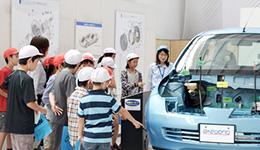Environmental Management
Promotion of Environmental Conservation Efforts Together with the Global Environmental Committee
ISO 14001 Certification Status and Scope
In June 1997, the Akebono Brake Group declared its "zero waste challenge" and positioned ISO 14001 as a basic tool for environmental management across the Group, working diligently to obtain certification.
In 1999, Miharu plant (closed in 2011) became the first plant in the Group to obtain ISO 14001 certification by promoting energy-saving production and waste reduction. Thereafter, Fukushima plant (currently Akebono Brake Fukushima Manufacturing Co., Ltd.), Akebono Brake Yamagata Manufacturing Co., Ltd., Sanyo Hydraulic Industry Co., Ltd. (currently Akebono Brake Sanyo Manufacturing Co., Ltd.), Akebono Brake Iwatsuki Manufacturing Co., Ltd. and Ai-City of Akebono Brake Industry Co., Ltd. acquired ISO 14001 certification, and certification for all sites in Japan was completed by 2003.
Audits of the environmental management system are conducted by external certification bodies for ISO 14001 certification renewal (every three years), external audits (annually), and internal audits conducted by in-house internal auditors (annually). Each domestic site reliably maintains the certification.
ISO 14001 Authentication Registration Application Scope
| Authentication Registration Regional Division |
Certification Authority | Registered Number | Initial Registration | Application Scope | Location |
|---|---|---|---|---|---|
| Akebono Brake Industry Co., Ltd. Ai-City |
Japan Automobile Research Institute |
JAER0461 | Mar 20, 2003 | Headquarters Ai-Village Akebono 123 Co., Ltd. |
〒348-8508 5-4-71 Higashi, Hanyu-City, Saitama 348-8508, Japan |
| Akebono FRESH Center | 〒348-8501 5-8-3 Higashi, Hanyu-City, Saitama 348-8501, Japan |
||||
| Akebono Kids Care Co., Ltd. | 〒348-0052 5-8-4 Higashi, Hanyu-City, Saitama 348-0052, Japan |
||||
| Alocs Corporation (Packing) | 〒348-0064 1327-1 Jonuma, Fujiikamigumi, Hanyu-City, Saitama 348-0064, Japan |
||||
| Tatebayashi Foundry (Casting of brake components) | 〒374-0001 6012 Aza-Tobu Kogyo Danchi, Oshima-cho, Tatebayashi-City, Gunma 374-0001, Japan |
||||
| Ai-Ring (Testing and evaluation) | 〒979-3112 41-42 Aza-Kosaruda, Uwadaira, Ogawa-machi, Iwaki-City, Fukushima 979-3112, Japan |
||||
| Akebono Brake Yamagata Manufacturing Co., Ltd. |
Japan Automobile Research Institute |
JAER0162 | Mar 15, 2000 | Akebono Brake Yamagata Manufacturing Co., Ltd. | 〒991-0061 161-3 Chuo Kogyo Danchi, Sagae-City, Yamagata 991-0061, Japan |
| Akebono Brake Fukushima Manufacturing Co., Ltd. |
Japan Automobile Research Institute |
JAER0163 | Mar 15, 2000 | Akebono Brake Fukushima Manufacturing Co., Ltd. |
〒969-1652 10 Aza-Shinjuku, Oaza-Narita, Koori-machi, Date-gun, Fukushima 969-1652, Japan |
| Akebono Brake Iwatsuki Manufacturing Co., Ltd. |
Japan Automobile Research Institute |
JAER0349 | Mar 29,2002 | Iwatsuki area | 〒339-8601 1190 Oaza-Kanamuro, Iwatsuki-ku, Saitama-City, Saitama 339-8601, Japan |
Ainohara area | 〒339-0071 24 Ainohara, Iwatsuki-ku, Saitama-City, Saitama 339-0071, Japan |
Alocs Corporation | 〒339-0071 255-1 Ainohara, Iwatsuki-ku, Saitama-City, Saitama 339-0071, Japan |
| Akebono Brake Sanyo Manufacturing Co., Ltd. |
Lloyd’s Register Quality Assurance Limited |
10436449 | May 25, 2001 | Headquarter Kibi plant No.1 |
〒710-1201 1966-8 Kushiro, Soja-City, Okayama 710-1201, Japan |
| Kibi plant No.2 | 〒710-1201 1920-3 Kushiro, Soja-City, Okayama 710-1201, Japan |
Environmental Targets and Results
Each function establishes targets for each fiscal year based on medium-term environmental targets, then carries out environmental preservation initiatives aiming to meet the targets. To connect these with the self-initiated actions of individual employees, the Akebono Brake Group conducts ongoing education to promote awareness of individual roles in environmental preservation activities. The achievement of these measures is evaluated each fiscal year and used to develop improvement plans for the following fiscal year and beyond.
Environmental Targets and FY2024 Results
| R&D | |
|---|---|
| Initiatives | |
| Promotion of products containing no substances of concern (SOCs) | |
| Medium- to Long-term Targets | |
| Complete conversion to lead-free sintered material by 2027 (for conventional trains and bullet trains) | |
| Targets for Fiscal 2024 | |
| Lead-free sintered material production rate greater than 62% | |
| Results Achieved in Fiscal 2024 | |
| Lead-free sintered material production rate is 64% | |
| Plans for Fiscal 2025 and Beyond | |
| Expansion of mass production of lead-free sintered materials | |
| Production | |
|---|---|
| 1 | Initiatives |
| Reduction of total CO2 emissions at manufacturing plants | |
| Medium- to Long-term Targets | |
|
FY2030: Reduce total CO2 emissions by 50% or more compared to FY2013 FY2050: Achieve carbon neutrality |
|
| Targets for Fiscal 2024 | |
| Targets have been set for each plant with a view to reducing total CO2 emissions by 50% in FY2030 compared to FY2013 levels | |
| Results Achieved in Fiscal 2024 | |
| CO2 emissions decreased by 3.7% year-on-year through activities such as halting idle production processes and reducing standby power | |
| Plans for Fiscal 2025 and Beyond | |
| Aim to reduce total CO2 emissions in FY2030 by 50% or more compared to FY2013 levels by continuing to promote energy conservation activities with the participation of all employees | |
| 2 | Initiatives |
| Continue and improve ISO 14001-related activities | |
| Medium- to Long-term Targets | |
| Continue to enhance environmental activities | |
| Targets for Fiscal 2024 | |
| Firmly root ISO 14001 in operations and steadily renew certifications | |
| Results Achieved in Fiscal 2024 | |
| Renewed ISO 14001 certifications | |
| Plans for Fiscal 2025 and Beyond | |
| Continue to firmly root ISO 14001 in operations and steadily renew certifications | |
| Environmental Education | |
|---|---|
| Initiatives | |
| Environmental training for all employees | |
| Medium- to Long-term Targets | |
| Develop human resources with a deep understanding of environmental activities and the ability to take the initiative | |
| Targets for Fiscal 2024 | |
| Development of environmental training | |
| Results Achieved in Fiscal 2024 | |
|
|
| Plans for Fiscal 2025 and Beyond | |
| Enhance the content of environmental training and continue its implementation | |
| Logistics | |
|---|---|
| Initiatives | |
| Improving energy usage efficiency by enhancing transportation efficiency in long-distance
logistics (introduction of new
multi-car trailers) Increasing loading efficiency through the establishment of foundational data for promoting IT utilization |
|
| Medium- to Long-term Targets | |
| FY2030: Reduce total CO2 emissions by 50% or more compared to FY2013 | |
| Targets for Fiscal 2024 | |
|
Reduce CO2 emissions by promoting more efficient transportation [Target values]
|
|
| Results Achieved in Fiscal 2024 | |
|
Improved long-distance transportation efficiency through domestic initiatives, promotion of
modal shift, and
establishment of a budget management process [Actual performance (compared to the previous year)]
|
|
| Plans for Fiscal 2025 and Beyond | |
|
|
| Purchasing | |
|---|---|
| Initiatives | |
| Promotion of green purchasing | |
| Medium- to Long-term Targets | |
| Establish structure that ensures purchasing activities in line with the Green Purchasing Guidelines | |
| Targets for Fiscal 2024 | |
|
|
| Results Achieved in Fiscal 2024 | |
|
|
| Plans for Fiscal 2025 and Beyond | |
|
|
| Production Engineering | |
|---|---|
| Initiatives | |
| Promotion of resource-saving designs | |
| Medium- to Long-term Targets | |
| Designing production equipment, dies, jigs, and other tooling aiming for reusable designs, and designs with high material yield, low energy consumption, and consideration of environmental impact | |
| Targets for Fiscal 2024 | |
|
|
| Results Achieved in Fiscal 2024 | |
|
|
| Plans for Fiscal 2025 and Beyond | |
|
|







